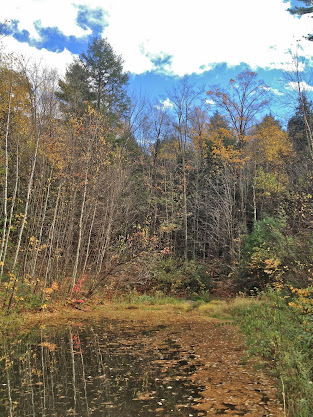October 30
Sunday.
A white frost this morning, lasting late into the day.
This has settled the accounts of many plants which lingered still.
P. M. – To Hubbard's Meadow Wood.
I see tree sparrows in loose flocks, chasing one an other, on the alders and willows by the brook-side. They keep up a general low and incessant twittering warble, as if suppressed, very sweet at this season, but not heard far. It is, as Wilson says, like a chip-bird, but this has a spot commonly on breast and a bright chestnut crown. It is quite striped (bay and brown with dark) above and has a forked tail.
I am not quite sure that I have seen them before. They are a chubby little bird, and have not the stripes on the breasts which the song sparrow has. The last, moreover, has not that striped bay and blackish and ash above.
By the bathing-place, I see a song sparrow with his full striped breast. He drops stealthily behind the wall and skulks amid the bushes ; now sits behind a post, and peeps round at me, ever restless and quirking his tail, and now and then uttering a faint chip. It is not so light beneath as the last.
The muskrat-houses are mostly covered with water now.
Saw a Solidago nemoralis in full flower yesterday.
Here is the autumnal dandelion and fragrant ever lasting to-day.
What with the rains and frosts and winds, the leaves have fairly fallen now. You may say the fall has ended.
Those which still hang on the trees are withered and dry.
I am surprised at the change since last Sunday. Looking at the distant woods, I perceive that there is no yellow nor scarlet there now.
They are (except the evergreens) a mere dull, dry red. The autumnal tints are gone.
What life remains is merely at the foot of the leaf-stalk.
The woods have for the most part acquired their winter aspect, and coarse, rustling, light-colored withered grasses skirt the river and the wood-side.
This is November. The landscape prepared for winter, without snow.
When the forest and fields put on their sober winter hue, we begin to look more to the sunset for color and variety.
Now, now is the time to look at the buds of the swamp-pink,— some yellowish, some, mixed with their oblong seed-vessels, red, etc.
The larger red maple buds have now two sets of scales, three in each.
The water andromeda is still green.
Along the Depot Brook, the great heads of Aster puniceus stand dry and fuzzy and singularly white, — like the goldenrods and other asters, — but some quite low are still green and in flower.
The prevalence of this light, dry color perhaps characterizes November, — that of bleaching withered grass, of the fuzzy gray goldenrods, harmonizing with the cold sunlight, and that of the leaves which still hang on deciduous trees.
The dead-looking fruit of the alders is now conspicuous.
H. D. Thoreau, Journal, October 30, 1853
"...the fall has ended." See
November 11, 1851 ("The fall of the year is over, and now let us see if we shall have any Indian summer.)
The prevalence of this light, dry color perhaps characterizes November, — that of bleaching withered grass. See
October 27, 1858 (“countless sedges and grasses ...become pale-brown and bleached after the frost has killed them, and give that peculiar light, almost silvery, sheen to the fields in November.”)
See also
This is November
I see tree sparrows in loose flocks, chasing one an other, on the alders and willows by the brook-side. See
November 4, 1860 ("White birch seed has but recently begun to fall. I see a quarter of an inch of many catkins bare. May have begun for a week. To-day also I see distinctly the tree sparrows, and probably saw them, as supposed, some days ago. Thus the birch begins to shed its seed about the time our winter birds arrive from the north.") See also
A Book of the Seasons, by Henry Thoreau,
the Tree Sparrow


















